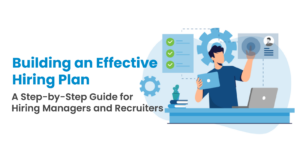Future-proofing your workforce requires more than recognizing and confronting existing skills gaps. To sustain success — and to attract and retain elite talent — organizations must also identify and prepare for future skills.
Emerging skills gaps among the current workforce have increased in recent years as organizations grapple with progressing technologies and the changes wrought by the pandemic and Great Resignation.
Forecasting future skills is not an exact science; every organization is different. But there are steps hiring managers and other workforce leaders can take to hone in on the unique future skills necessary for their organizations.
Follow your organizational roadmap
Predicting future skills may not be precise, but it also doesn’t mean looking into a hazy crystal ball.
Let your business strategy guide you as you develop and define future skills. Follow your product or services roadmap and your technology roadmap.
Consider how talent recruiting and workforce management fit in. A recent HR Dive article about new and future skills notes that talent acquisition and retention over the next decade is a paramount concern for most employers.
Therefore, organizations must incorporate their talent strategies with their business plans. To do so, evaluate the success of your current approach to sourcing, hiring, and retaining talent compared to the talent pipeline for your organization and field.
Create a skills taxonomy
Develop a skills classification system that includes the requirements necessary to meet current needs and a projection of how those skills may evolve and what new skills may be necessary over the next five or more years.
A recent report about discerning skills gaps and future skills by the consulting firm McKinsey & Company recommends establishing a “skills taxonomy.” This taxonomy should be based on three key sources:
- Existing skills taxonomies: Assess your organization’s past and current work; examine skills taxonomies from competitors or similar organizations; look to industry associations and research organizations for insights into skills trends.
- Skills analytics: Leverage the analytics available from your own organization, professional associations and social networks to spot in-demand skills and pinpoint changes; monitor job postings in your organization’s field for skills tendencies.
- Expert perspectives: Reach out to internal leadership, valued employees and other industry specialists for knowledge-based predictors of future skills.
This blend of hard data and information-driven projections can help draft a taxonomy that distinguishes specialized, hard, and soft skills and demonstrates how those skills relate to current and future needs.
Look beyond hard skills
When evaluating future skills, don’t limit your scope to technical skills. Consider the so-called soft skills or the abilities and traits your workforce will need to maintain success.
Approximately half of the existing workforce will need to learn new skills by 2025, according to the most recent Future of Jobs report by the World Economic Council (WEC). The WEC has tracked future skills for more than a half-decade, but in 2020 it added soft skills and self-management skills.
Soft and self-management skills the WEC considers crucial future skills include but are not limited to:
- Active learning
- Analytical thinking
- Creative thinking
- Digital literacy
- Flexibility
- Problem-solving
The importance of soft skills may actually grow as technology advances and is adopted more broadly. As the WEC report documents, hard skills often lag in relation to technology adoption and rely on those with high-level soft skills like cognitive learning capabilities and self-motivation to fill the gaps.
Engage your workforce
Involve your leadership and greater workforce in the process of determining future skills.
Career advancement and professional development opportunities are important to workers, and so is having a voice in an organization’s future. Seeking input across your organizational teams and hierarchies builds culture and demonstrates that an organization is invested in its employees’ futures.
Existing talent can also provide a wealth of detail to inform your skills taxonomy. Current workers are often excellent resources for shifting skill sets. A survey of workers about current, desired and projected skills by job role can be beneficial on multiple fronts.
A recent Chief Learning Officer article about skills development observes that this collaborative process empowers employees, helps employers identify the learners and adapters within their organizations, and supports the development of appropriate skills-centric programs.
Enact upskilling and reskilling initiatives
One way to keep pace with advancing skills and help ascertain future skills is through upskilling and reskilling programs.
A recent WEC article discusses how upskilling and reskilling initiatives help organizations retain valuable talent, maintain institutional knowledge and prepare for future needs. Such programs can also provide effective returns on their investments by keeping skilled talent in-house and saving on the costs of sourcing, onboarding and training new talent.
The WEC posits that a mix of high-level technical skills and self-management skills will remain hot commodities for the foreseeable future and that skilled workers already recognize this as well as their power in the labor market.
It’s impossible to predict the future with 100% accuracy, but organizations that want to thrive in years to come must plan for the skills required to get there.
The Re-Imagined Recruitment Playbook
Over the past two years, we have captured hard won lessons learned across thousands of worker hiring engagements by our team of professional recruiters and distilled them into practical ideas that you can start using immediately. The Re-Imagined Recruitment Playbook is a step-by-step guide to help source, screen, select, onboard and retain talent in the New World of Work.




